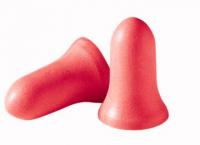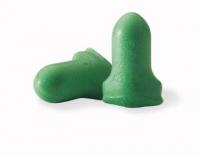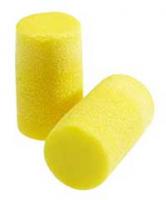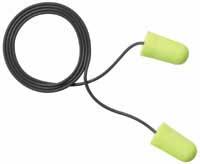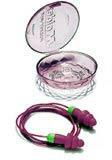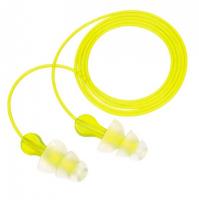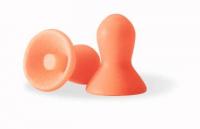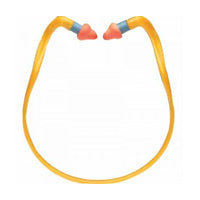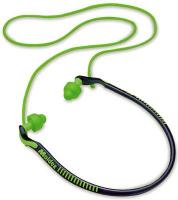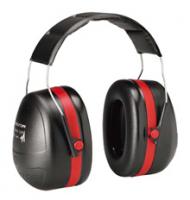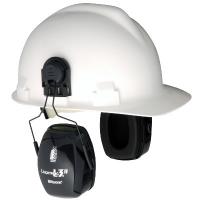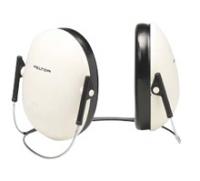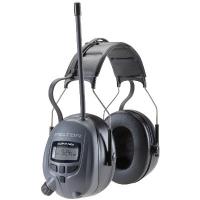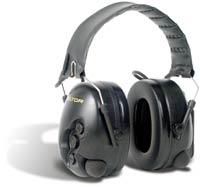HEARING PROTECTION SELECTION GUIDE
Resource Center Topics
Coronavirus Information
Ebola Information
Ebola Virus Information
Ebola Donning
Ebola Doffing & Disposal
Hearing Protection
Avian Bird Flu Information
Chemical Safety
General Workplace Safety
Basic First Aid
Ergonomics
OSHA Checklist for General Industry
Welding Safety
Healthcare/Laboratory
Electrical Safety
HEARING PROTECTION SELECTION GUIDE
Introduction to Noise Exposure Regulations
Noise-induced hearing loss has been called the most common permanent and preventable occupational injury. According to U.S. federal law, it is the responsibility of the Occupational Safety and Health Administration [OSHA] to regulate permissible noise exposure levels in the workplace. The OSHA CFR 1910.95 regulation requires employers first to utilize "engineering controls" to reduce noise levels in their work environments. Should these controls fail to reduce noise to acceptable limits, the regulation states that "personal protective equipment shall be provided and used to reduce sound levels."
Employers are also required to implement an "effective hearing conservation program" whenever employee noise exposure levels equal or exceed an 8-hour time-weighted average sound level (TWA) of 85 dB. As part of the conservation program, sound levels must be monitored and documented, and noise-exposed employees must receive annual training and audiometric testing, and be "fitted with hearing protectors, trained in their use and care, and required to use them."
Employers must provide their employees a variety of hearing protection to choose from, training on use and maintenance of hearing protectors and ensure that hearing protection is worn by all employees who meet the requirements of this standard.
Noise Reduction Rating
Noise Reduction Rating (NRR) is the hearing protection rating method used in the U.S. The current range of NRR available in the U.S. market extends from 0 to 33 decibels. The NRR is derived from an involved calculation that begins with attenuation test results from at least ten laboratory subjects across a range of frequencies. Two standard deviations are factored in to account for individual user variation, and several corrections and cushions are included to make the NRR applicable to a broader population, and a wide variety of noise sources. While it is not a perfect real-world measure of attenuation, the NRR is the most standardized method currently in use for describing a hearing protector's attenuation in a single number. The NRR estimates the amount of protection achievable by 98% of users in a laboratory setting when hearing protectors are properly fitted. The higher the NRR the greater the noise level is reduced.
Types of Hearing Protection
A wide variety of hearing protection products are available and each type offers its own unique set of advantages and disadvantages. The most common types are: Disposable Earplugs
These are the most common type of protection. They are usually made of a PVC (polyvinyl chloride) or PU (polyurethane) foam. Disposable earplugs are compressed or rolled-down prior to insertion and then slowly re-expand to fill the ear canal. These earplugs are usually available with or without a pre-attached cord and are usually one-size-fit-all (some sized earplugs are also be available). Metal detectable earplugs are also available and are mainly used in food processing and can be recognized by contamination sensors in the processing line. Disposable earplugs offer an economical and convenient choice for work situations that demand a high degree of comfort, frequent changes, or where hygiene presents a problem for reuse.
Here are a few examples from our large selection
Push-in Foam Earplugs
Push-in foam earplugs are the newest type of hearing protection and combine the easy use and fit benefits of a reusable earplug with the cost and comfort advantages of a disposable earplug. The earplug combines an ultra-soft earplug with an insertion tip and requires no rolling or touching plug portion during insertion. This reduces the concern of inserting earplugs with soiled hands.
Reusable Earplugs
Reusable earplugs are made usually made from silicone and tapered to fit the ear canal. They are intended to be reused and can be cleaned using soap and water. They are available either corded or uncorded and in metal detectable styles for food processing. While these are more durable than disposable earplugs, they typically have a lower NRR. Both reusable and disposable earplugs are small enough to be used with any other head/face/eye protective equipment such as hard hats, face shields or safety glasses. Reusable earplugs are ideal for environments where workers can retain and store earplugs for reuse over time - reducing waste and saving money.
Here are a few examples from our large selection.
Hearing Bands
Hearing Bands consist of a pair of earplugs connected to a flexible band and most styles can be worn in different positions (over-the-head, under-the chin or behind the neck). The NRR of these bands is similar to most reusable earplugs. The band allows this item to be stored around the neck while not in use. Depending on which position the band is worn in, these can be used with most hardhats, face shield or glasses. Hearing bands are a great alternative for those who work in intermittent noise or managers/visitors who move in and out of noise.
Here are a few examples from our large selection.
Earmuffs
Earmuffs offer comfort without any direct pressure inside the ear canal for greater comfort. Earmuffs are usually constructed of all plastic materials (these are called dielectric and are ideal for work around electrical hazards) or a combination of metal and plastic for added durability. The three common designs of earmuffs are the standard over-the-head (see Figure 4a.), cap-mounted (Figure 4b.) and behind-the-neck (Figure 4c.). The cap-mounted earmuffs are design to mount directly to most hard hats that have side-accessory slots and the behind-the-neck style can also be used while wearing a hard hat or face shields. Low profile behind the neck earmuffs are commonly used by welders since they will fit inside of a welding helmet.
Here are a few examples from our large selection.
Electronic Earmuffs
These provide the same protection as standard earmuffs but also offer other features such as AM/FM radio reception, two-way radio reception or amplification of low sound levels. Electronic earmuffs are used for a variety of uses including workplace hearing protection, hunting hearing protection and military hearing protection. Electronic headsets can also offer two way communications either through the use of a two way radio or through a radio headset that has an integrated two way radio. Also available is an extensive line of tactical and military headsets.
Here are a few examples from our large selection.
Frequently Asked Questions
Q. Can earmuffs and earplugs be used together to provide more noise reduction?
A.Dual protection is normally recommended for noise environments with exposures exceeding a time-weighted average level of 105 dBA, or for users who simply wish to block additional sound for extra hearing protection. When wearing an earmuff and an earplug, OSHA gives credit for 5-dB of additional protection above that of the higher attenuating device.
Q. How dangerous is gunfire to my hearing?
A. The sound of gunfire is the most hazardous non-occupational noise to which Americans are exposed. The table below lists the peak sound pressure levels of typical guns. What is so dangerous about peak levels such as these is that a single shot experienced by an unprotected ear can lead to immediate and permanent hearing loss, often accompanied by tinnitus (ringing, hissing, or humming in the ears). Just because you might have shot without protection in the past, and without apparent hearing loss, does not mean you might not get hurt the next time. Exposure to peaks sound pressures can be likened to dropping a glass bottle. Sometimes it breaks and sometimes it doesn't; you can't predict the outcome.
Hearing protection should always be worn when firing guns. Some will even choose to use dual protection because it reduces the sounds even further for greater protection, and for some, for better shooting as well (since the pulses are lower and the likelihood of flinching is reduced).
Peak Sound Pressure Levels (SPL)Type of Gun SPL (dB).44 Revolver 170 dB45 Automatic 165 dBM-16 160 dB.357 Revolver 160 dB12 Gauge Shotgun 155 dB.38 Revolver 150 dB.22 Rifle 145 dB
Q. Can earmuffs be worn over safety eyewear without affecting attenuation?
A. In tests conducted by Howard Leight, safety glasses that had a thin frame (a width of 2mm or less at the temples where the earmuff cushion meets the frame), the eyewear caused no significant decline in attenuation
Sources for More Information
Please Note: The information contained in this publication is intended for general information purposes only. This publication is not a substitute for review of the applicable government regulations and standards, and should not be construed as legal advice or opinion. Readers with specific questions should refer to the cited regulation or consult with an attorney.
Return to customer center
Hearing Protection Anchorage: How to Protect Your Ears from Noise
Noise is one of the most common occupational hazards in many industries, especially in construction, manufacturing, and mining. Exposure to loud noise for extended periods can cause permanent damage to your hearing, which can affect your quality of life and productivity. That's why it's important to use proper hearing protection anchorage whenever you work in noisy environments.
OSHA Approved Ear Muffs: A Reliable Choice for Hearing Protection
One of the most effective and comfortable ways to protect your ears from noise is to use OSHA approved earmuffs. Earmuffs are devices that cover your ears completely and block out the sound waves from reaching your inner ear. They are easy to wear and adjust, and they come in different sizes and styles to suit your preferences.
Earmuffs are rated by their noise reduction rating (NRR), which indicates how much they can reduce the noise level in decibels (dB). The higher the NRR, the more protection they offer. For example, if you work in an environment with a noise level of 100 dB, and you wear earmuffs with an NRR of 30 dB, the noise level reaching your ears will be 70 dB, which is below the OSHA limit of 85 dB for an 8-hour exposure.
Hearing Aids: A Solution for Hearing Loss
If you already have hearing loss due to noise exposure or other causes, you may benefit from using hearing aids. Hearing aids are devices that amplify the sounds around you and deliver them to your ears through a speaker or a receiver. They can help you hear better in various situations, such as conversations, meetings, and phone calls.
Varieties of hearing aids are available, tailored to your hearing loss level, ear anatomy, and individual lifestyle preferences. Some of the common types are:
- Behind-the-ear (BTE): The device sits behind your ear and connects to a custom-made ear mold that fits in your ear canal.
- In-the-ear (ITE): The device fits entirely in your outer ear and has a microphone and a speaker.
- In-the-canal (ITC): The device fits partially in your ear canal and has a microphone and a speaker.
- Completely-in-the-canal (CIC): The device fits completely in your ear canal and has a microphone and a speaker.
Hearing aids require regular maintenance and care, such as cleaning, changing batteries, and adjusting settings. You should also consult with an audiologist or a hearing specialist to get a proper diagnosis, fitting, and follow-up.
Latest Technology: How to Enhance Your Hearing Experience
If you want to enjoy the best sound quality and comfort with your hearing protection anchorage or hearing aids, you should consider using the latest technology available. Some of the features that can enhance your hearing experience are:
- Bluetooth connectivity: This allows you to stream audio from your smartphone, tablet, laptop, or TV directly to your ear muffs or hearing aids, without any wires or cords.
- Noise cancellation: This reduces the background noise and enhances the speech clarity in noisy environments.
- Directional microphones: This allows you to focus on the sounds coming from a specific direction, such as the person you are talking to.
- Feedback suppression: This prevents the annoying whistling sound that can occur when the sound from the speaker leaks back to the microphone.
- Musician plugs: These are special ear plugs that reduce the noise level without distorting the sound quality. They are ideal for musicians, singers, DJs, and music lovers who want to protect their hearing while enjoying their favorite tunes.
NRR vs dB: Choosing the Right Ear Protection Decibel Level
Noise-Induced Hearing Loss and Its Consequences
Noise-induced hearing loss is a serious and irreversible condition that affects millions of people around the world. Exposure to loud sounds can damage the delicate hair cells in the inner ear, resulting in permanent hearing loss and tinnitus. To prevent this, it is important to wear hearing protection devices whenever you are exposed to noise levels above 85 decibels (dB).
Understanding NRR and Its Relation to dB
What is NRR and How Does It Relate to dB?
NRR stands for Noise Reduction Rating, and it is a measure of how much a hearing protection device can reduce the noise level in your ears. NRR is expressed in decibels, which means that a higher NRR indicates a higher level of protection. For example, if you are exposed to a noise level of 100 dB, and you wear a hearing protection device with an NRR of 25 dB, the noise level in your ears will be reduced to 75 dB.
The NRR Correction Factor
However, NRR is not a direct subtraction from the noise level. This is because NRR is based on laboratory tests that may not reflect real-world conditions. Therefore, to get a more accurate estimate of the noise level in your ears, you need to apply a correction factor of 7 dB. This means that you need to subtract 7 dB from the NRR before subtracting it from the noise level. For example, if you wear a hearing protection device with an NRR of 25 dB, the actual noise reduction will be 25 - 7 = 18 dB. So, if you are exposed to a noise level of 100 dB, the noise level in your ears will be 100 - 18 = 82 dB.
Choosing the Right Hearing Protection Device
Types of Hearing Protection Devices
There are two main types of hearing protection devices: earplugs and earmuffs. Earplugs are small devices that fit inside your ear canal and block out the noise. Earmuffs are larger devices that cover your entire ear and create a seal around it. Both types of devices have different advantages and disadvantages, depending on your preferences and needs.
Considerations for Choosing.
To choose the right hearing protection device for you, you need to consider several factors, such as:
- The noise level and frequency of your environment
- The duration and frequency of your exposure
- The fit and comfort of the device
- The compatibility with other personal protective equipment
- The cost and availability of the device
As a rule of thumb, you should choose a hearing protection device that has an NRR that is high enough to reduce the noise level in your ears below 85 dB. You should also choose a device that fits well and feels comfortable in your ears. You may need to try different types and sizes of devices to find the best one for you.
Advantages and Disadvantages
- Earplugs: Usually more discreet, comfortable, and convenient than earmuffs. Effective at blocking out high-frequency sounds. However, insertion/removal difficulties and potential for ear irritation.
- Earmuffs: Usually more visible and bulkier, but easier to put on/take off. Effective at blocking out low-frequency sounds. Can interfere with glasses, hats, or hairstyles.
The Importance of Wearing Hearing Protection Devices
Health and Safety Considerations
Wearing hearing protection devices is not just a matter of personal preference or comfort; it is also a matter of health and safety. Hearing loss can have serious consequences for your physical, mental, and social well-being. Some effects of hearing loss include:
- Difficulty communicating with others.
- Reduced performance at work or school
- Increased risk of accidents or injuries
- Increased stress and fatigue
- Reduced quality of life
- Depression and isolation
By wearing hearing protection devices whenever you are exposed to loud noises, you can protect your hearing and prevent these negative outcomes. This way, you can enjoy the sounds that matter to you without compromising your health.
Ear Protection for Mechanics - A Sound Investment for Safety
If you're a mechanic or work in an environment with loud machinery, you know the importance of protecting your hearing. PPE ear protection, commonly known as ear defenders, is your first line of defense against potentially irreversible hearing damage. Let's explore the different types of ear defenders and discover the best hearing protection options available, including soft foam ear cushions and over-the-ear protection.
Types of Ear Defenders
When it comes to ear protection, one size doesn’t fit all. There are various types of ear defenders designed to cater to different needs and preferences:
Earmuffs - Over-the-Ear Protection
Earmuffs, providing over-the-ear protection, are a popular choice among mechanics and industrial workers. They offer excellent noise reduction and are comfortable to wear for extended periods. Some models even come equipped with soft foam ear cushions for added comfort.
Earplugs - Compact and Effective
Earplugs are a more discreet option, ideal for mechanics who need to move around freely. They come in disposable or reusable varieties, and some are designed with soft foam for enhanced comfort. Earplugs effectively block out noise and are easy to carry in your pocket or toolbox.
Noise-Canceling Earmuffs - Advanced Protection
For those working in exceptionally noisy environments, noise-canceling earmuffs are a game-changer. These high-tech ear defenders not only provide excellent noise reduction but also actively cancel out unwanted background sounds, like wind noise.

